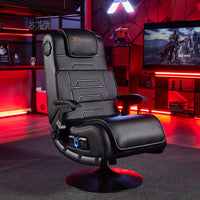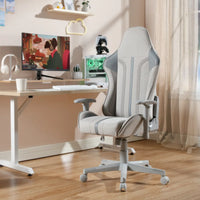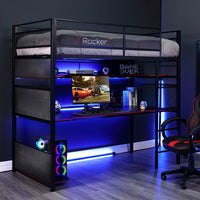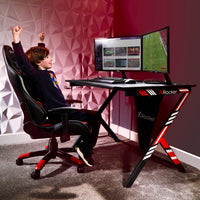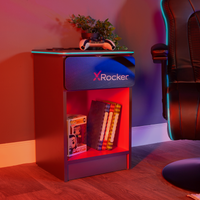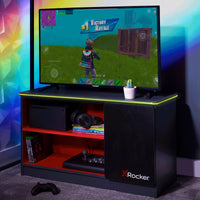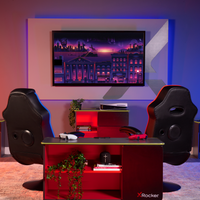In today’s digital age, gaming has become a favorite pastime for many children. However, this can often lead to excessive gaming and even addiction. As parents, finding ways to manage and moderate children's gaming time is crucial. One innovative tool that can support this effort is the gaming chair. Specifically, integrating gaming chairs like console gaming chairs, X Rocker gaming chairs, and PC gaming chairs into a broader strategy can significantly help parents control their children's gaming habits.
Understanding Gaming Addiction
Before delving into how gaming chairs can help, it's essential to understand what gaming addiction is. Gaming addiction, officially recognized by the World Health Organization as a gaming disorder, is characterized by impaired control over gaming, increasing priority given to gaming over other activities, and continuation of gaming despite negative consequences. Children who are addicted to gaming often exhibit signs such as neglecting schoolwork, losing interest in other activities, and experiencing changes in mood or behavior.
The Role of Gaming Chairs in Managing Gaming Time
Gaming chairs, particularly ergonomic models, can play a significant role in promoting healthier gaming habits. These chairs are designed to support the body during extended periods of sitting, which can help reduce the physical strain and discomfort associated with prolonged gaming. However, the benefits extend beyond mere physical comfort.
Ergonomic Benefits
- Promoting Better Posture: Gaming chairs are designed to support proper posture, which can reduce the likelihood of developing back and neck pain. When children are comfortable, they are less likely to adopt unhealthy postures that can lead to long-term issues. A console gaming chair, for instance, provides adequate lumbar support, encouraging children to sit upright.
- Reducing Physical Discomfort: Comfortable seating can help reduce the tendency to game for extended periods. When a child starts to feel discomfort, they are more likely to take breaks. This natural interruption can be a cue for parents to encourage other activities or set limits on gaming time.
Psychological and Behavioral Benefits
- Creating a Designated Gaming Space: By using a specific gaming chair, parents can create a designated gaming space for their children. This spatial distinction can help in setting boundaries. When the child is not in their gaming chair, it can signal that it’s time for other activities. This can help in developing a routine and reducing impulsive gaming.
- Encouraging Structured Gaming Time: Gaming chairs can be incorporated into a broader strategy of structured gaming time. For example, parents can allow gaming only when the child uses their designated chair. This can help in monitoring and limiting gaming sessions. An X Rocker gamer chair with built-in speakers and vibration can make gaming sessions more immersive but can also be used as a reward for completing homework or chores, making gaming time a privilege rather than a default activity.
Integrating Gaming Chairs into a Broader Strategy
While gaming chairs can provide significant benefits, they are most effective when integrated into a comprehensive strategy for managing gaming time. Here are some steps parents can take:
Setting Clear Rules and Boundaries
- Establish Time Limits: Parents should set clear and consistent time limits for gaming. This can include daily or weekly caps on gaming hours. Using a gaming chair as part of this routine can reinforce these limits. For instance, once the time is up, the child must leave the gaming chair and switch to another activity.
- Scheduled Breaks: Encouraging regular breaks can prevent prolonged gaming sessions. Parents can use the gaming chair to implement a "break schedule," where children must get up and move around every hour. This can be enforced by setting timers and rewarding compliance.
Parental Involvement and Monitoring
- Active Participation: Parents can take an active interest in their children's gaming by playing together occasionally. This can provide an opportunity to bond and monitor the type of games played and the duration of gaming sessions.
- Use of Parental Controls: Most gaming consoles and PCs have built-in parental control features. Parents can use these tools to set time limits, restrict access to certain games, and monitor gaming activity. Combining these controls with the physical presence of a gaming chair can create a more controlled gaming environment.
Encouraging Social Interaction
- Family Time: Parents should prioritize family activities and ensure that gaming does not interfere with family time. Regular family meals, outings, and game nights can help in maintaining a balanced lifestyle.
- Social Activities: Encouraging children to participate in social activities outside of gaming can help reduce dependency on gaming for social interaction. This can include joining clubs, engaging in group sports, or attending community events.
Choosing the Right Gaming Chair
When selecting a gaming chair to aid in moderating gaming time, parents should consider several factors:
- Comfort and Ergonomics: A good gaming chair should provide adequate support and comfort. Ergonomic features such as lumbar support, adjustable armrests, and reclining capabilities are essential. Chairs like the X Rocker gamer chair and PC gaming chairs often come with these features.
- Durability and Quality: Investing in a high-quality gaming chair ensures that it will last longer and provide consistent support. Brands known for their durability and quality can be more cost-effective in the long run.
- Additional Features: Some gaming chairs come with additional features such as built-in speakers, vibration motors, and Bluetooth connectivity. These features can make gaming more enjoyable and immersive, turning gaming time into a more structured and rewarding experience.
Conclusion
Gaming chairs can be a valuable tool in helping parents manage and moderate their children's gaming time. By promoting better posture, reducing physical discomfort, and creating a designated gaming space, these chairs can support healthier gaming habits. However, the most effective results are achieved when gaming chairs are integrated into a broader strategy that includes setting clear rules, encouraging alternative activities, and active parental involvement. By taking a comprehensive approach, parents can help their children enjoy gaming in moderation, reducing the risk of addiction and promoting a balanced lifestyle.

 Spanish
Spanish
